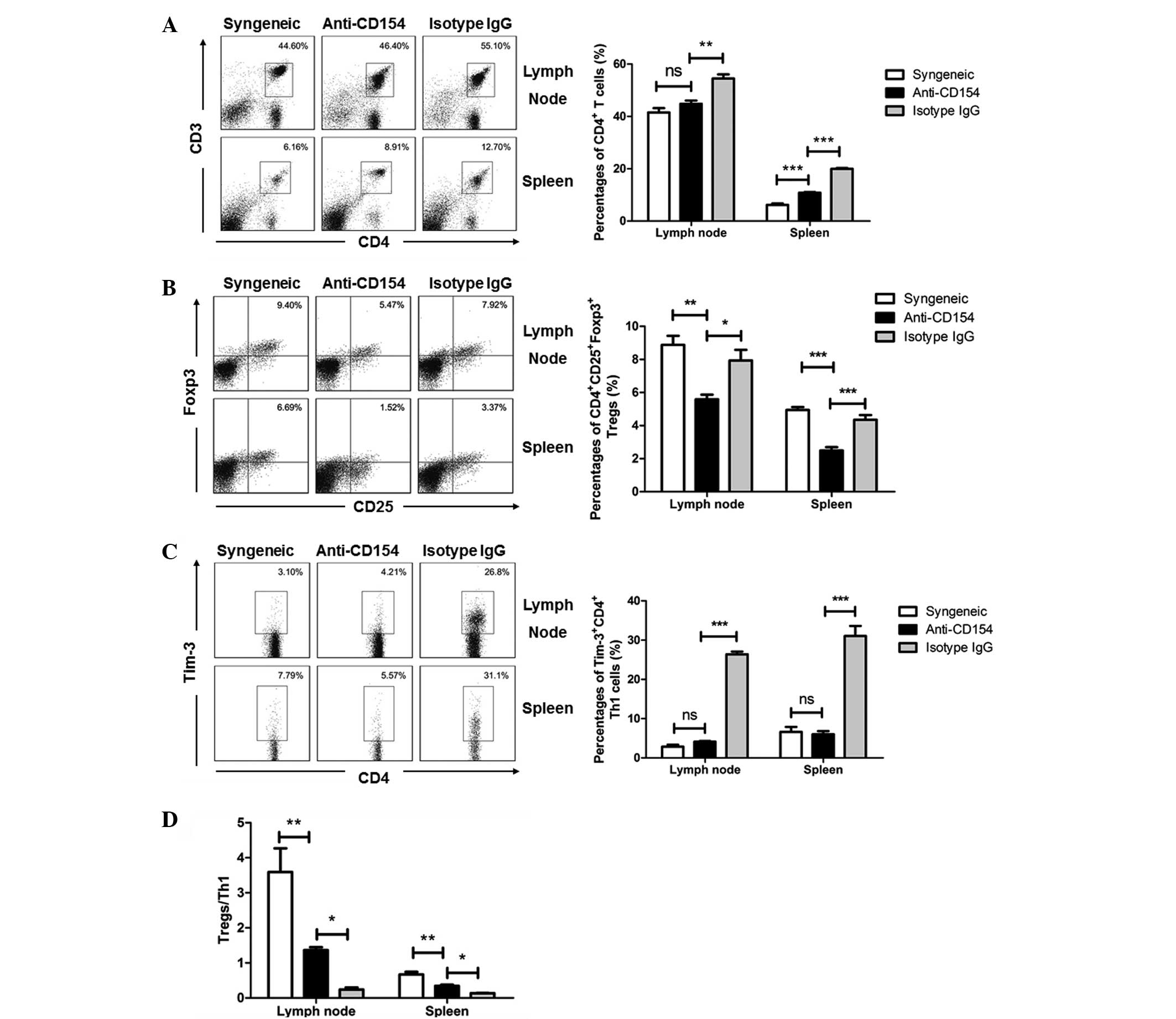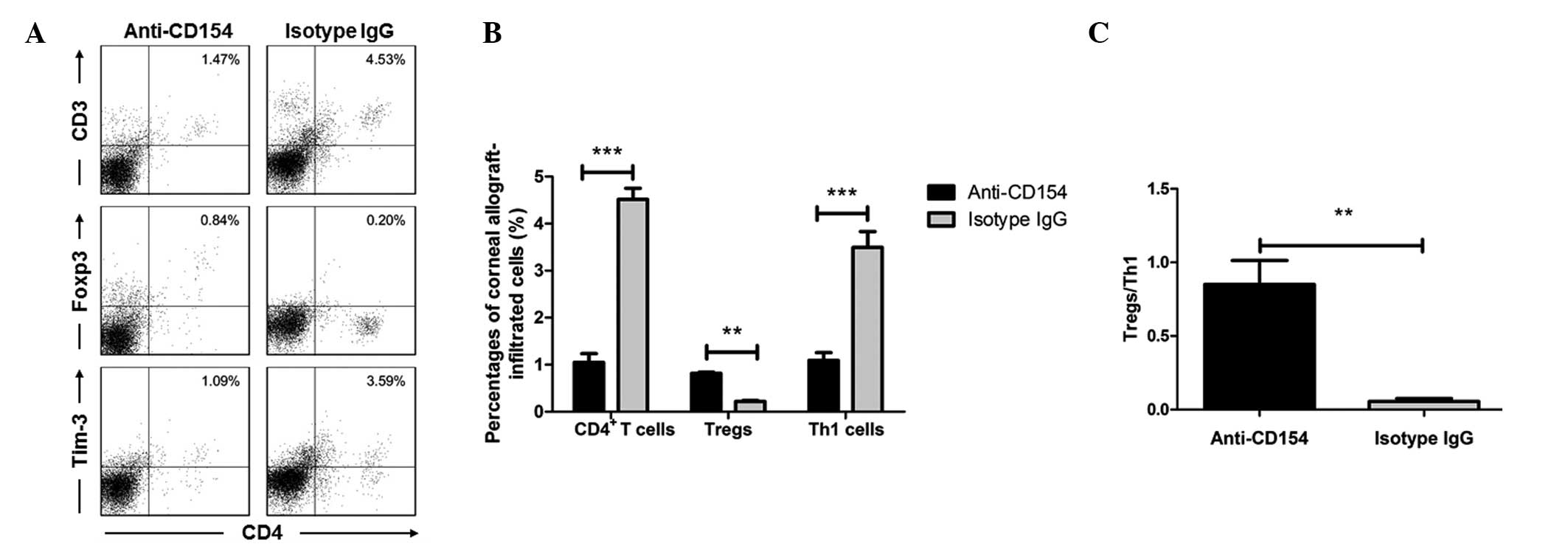|
1
|
Watson MP, George AJ and Larkin DF:
Differential effects of costimulatory pathway modulation on corneal
allograft survival. Invest Ophthalmol Vis Sci. 47:3417–3422. 2006.
View Article : Google Scholar : PubMed/NCBI
|
|
2
|
Raizman M: Corticosteroid therapy of eye
disease. Fifty years later. Arch Ophthalmol. 114:1000–1001.
1996.PubMed/NCBI
|
|
3
|
Shimazaki J, Den S, Omoto M, Satake Y,
Shimmura S and Tsubota K: Prospective, randomized study of the
efficacy of systemic cyclosporine in high-risk corneal
transplantation. Am J Ophthalmol. 152:33–39. 2011. View Article : Google Scholar : PubMed/NCBI
|
|
4
|
Birnbaum F, Reis A, Böhringer D, et al: An
open prospective pilot study on the use of rapamycin after
penetrating high-risk keratoplasty. Transplantation. 81:767–772.
2006. View Article : Google Scholar : PubMed/NCBI
|
|
5
|
Yamada J, Kurimoto I and Streilein JW:
Role of CD4+ T cells inimmunobiology of orthotopic corneal
transplants in mice. Invest Ophthalmol Vis Sci. 40:2614–2621.
1999.
|
|
6
|
Bromley SK, Iaboni A, Davis SJ, et al: The
immunological synapse and CD28-CD80 interactions. Nat Immunol.
2:1159–1166. 2001.PubMed/NCBI
|
|
7
|
Thiel MA, Kaufmann C, Coster DJ and
Williams KA: Antibody-based immunosuppressive agents for corneal
transplantation. Eye (Lond). 23:1962–1965. 2009. View Article : Google Scholar : PubMed/NCBI
|
|
8
|
Thiel MA, Coster DJ, Standfield SD, et al:
Penetration of engineered antibody fragments into the eye. Clin Exp
Immunol. 128:67–74. 2002. View Article : Google Scholar : PubMed/NCBI
|
|
9
|
Ford ML and Larsen CP: Translating
costimulation blockade to the clinic: lessons learned from three
pathways. Immunol Rev. 229:294–306. 2009. View Article : Google Scholar : PubMed/NCBI
|
|
10
|
Kirk AD, Burkly LC, Batty DS, et al:
Treatment with humanized monoclonal antibody against CD154 prevents
acute renal allograft rejection in nonhuman primates. Nat Med.
5:686–693. 1999. View
Article : Google Scholar : PubMed/NCBI
|
|
11
|
Kirk AD, Blair PJ, Tadaki DK, Xu H and
Harlan DM: The role of CD154 in organ transplant rejection and
acceptance. Philos Trans R Soc Lond B Biol Sci. 356:691–702. 2001.
View Article : Google Scholar : PubMed/NCBI
|
|
12
|
Arefanian H, Tredget EB, Rajotte RV, Gill
RG, Korbutt GS and Rayat GR: Short-term administrations of a
combination of anti-LFA-1 and anti-CD154 monoclonal antibodies
induce tolerance to neonatal porcine islet xenografts in mice.
Diabetes. 59:958–966. 2010. View Article : Google Scholar : PubMed/NCBI
|
|
13
|
Zhang J, Li H, Jiang N, et al: Effects of
gene transfer CTLA4Ig and anti-CD40L monoclonal antibody on islet
xenograft rejection in mice. Transplant Proc. 42:1835–1837. 2010.
View Article : Google Scholar : PubMed/NCBI
|
|
14
|
Qian Y, Boisgerault F, Benichou G and Dana
MR: Blockade of CD40-CD154 costimulatory pathway promotes survival
of allogeneic corneal transplants. Invest Ophthalmol Vis Sci.
42:987–994. 2001.PubMed/NCBI
|
|
15
|
Qian Y and Dana MR: Effect of locally
administered anti-CD154 (CD40 ligand) monoclonal antibody on
survival of allogeneic corneal transplants. Cornea. 21:592–597.
2002. View Article : Google Scholar : PubMed/NCBI
|
|
16
|
Ardjomand N, McAlister JC, Rogers NJ, Tan
PH, George AJ and Larkin DF: Modulation of costimulation by CD28
and CD154 alters the kinetics and cellular characteristics of
corneal allograft rejection. Invest Ophthalmol Vis Sci.
44:3899–3905. 2003. View Article : Google Scholar : PubMed/NCBI
|
|
17
|
Snyder JT, Shen J, Azmi H, Hou J, Fowler
DH and Ragheb JA: Direct inhibition of CD40L expression can
contribute to the clinical efficacy of daclizumab independently of
its effects on cell division and Th1/Th2 cytokine production.
Blood. 109:5399–5406. 2007. View Article : Google Scholar : PubMed/NCBI
|
|
18
|
Burrell BE, Lu G, Li XC and Bishop DK:
OX40 costimulation prevents allograft acceptance induced by
CD40-CD40L blockade. J Immunol. 182:379–390. 2009. View Article : Google Scholar : PubMed/NCBI
|
|
19
|
Qian Y, Hamrah P, Boisgerault F, et al:
Mechanisms of immunotherapeutic intervention by anti-CD154 (CD40L)
antibody in high-risk corneal transplantation. J Interferon
Cytokine Res. 22:1217–1225. 2002. View Article : Google Scholar : PubMed/NCBI
|
|
20
|
Chen M, Xiao X, Demirci G and Li XC: OX40
controls islet allograft tolerance in CD154 deficient mice by
regulating Foxp3+ Tregs. Transplantation. 85:1659–1662.
2008. View Article : Google Scholar : PubMed/NCBI
|
|
21
|
Huq S, Liu Y, Benichou G and Dana MR:
Relevance of the direct pathway of sensitization in corneal
transplantation is dictated by the graft bed microenvironment. J
Immunol. 173:4464–4469. 2004. View Article : Google Scholar : PubMed/NCBI
|
|
22
|
Muller YD, Mai G, Morel P, et al:
Anti-CD154 mAb and rapamycin induce T regulatory cell mediated
tolerance in rat-to-mouse islet transplantation. PLoS one.
5:e103522010. View Article : Google Scholar : PubMed/NCBI
|
|
23
|
Cunnusamy K, Chen PW and Niederkorn JY:
IL-17 promotes immune privilege of corneal allografts. J Immunol.
185:4651–4658. 2010. View Article : Google Scholar : PubMed/NCBI
|
|
24
|
Cunnusamy K, Paunicka K, Reyes N, Yang W,
Chen PW and Niederkorn JY: Two different regulatory T cell
populations that promote corneal allograft survival. Invest
Ophthalmol Vis Sci. 51:6566–6574. 2010. View Article : Google Scholar : PubMed/NCBI
|
|
25
|
Shen L, Jin Y, Freeman GJ, Sharpe AH and
Dana MR: The function of donor versus recipient programmed
death-ligand 1 in corneal allograft survival. J Immunol.
179:3672–3679. 2007. View Article : Google Scholar : PubMed/NCBI
|
|
26
|
Fu H, Larkin DF and George AJ: Immune
modulation in corneal transplantation. Transplant Rev (Orlando).
22:105–115. 2008. View Article : Google Scholar : PubMed/NCBI
|
|
27
|
Rodrigues EB, Farah ME, Maia M, et al:
Therapeutic monoclonal antibodies in ophthalmology. Prog Retin Eye
Res. 28:117–144. 2009. View Article : Google Scholar
|
|
28
|
Rothstein DM and Sayegh MH: T-cell
costimulatory pathways in allograft rejection and tolerance.
Immunol Rev. 196:85–108. 2003. View Article : Google Scholar : PubMed/NCBI
|
|
29
|
Thiel MA, Coster DJ and Williams KA: The
potential of antibody-based immunosuppressive agents for corneal
transplantation. Immunol Cell Biol. 81:93–105. 2003. View Article : Google Scholar : PubMed/NCBI
|
|
30
|
Nickerson P, Steurer W, Steiger J, Zheng
X, Steele AW and Strom TB: Cytokines and the Th1/Th2 paradigm in
transplantation. Curr Opin Immunol. 6:757–764. 1994. View Article : Google Scholar : PubMed/NCBI
|
|
31
|
Hall BM, Tran G and Hodgkinson SJ:
Alloantigen specific T regulatory cells in transplant tolerance.
Int Immunopharmacol. 9:570–574. 2009. View Article : Google Scholar : PubMed/NCBI
|
|
32
|
Gorantla VS, Schneeberger S, Brandacher G,
et al: T regulatory cells and transplantation tolerance. Transplant
Rev (Orlando). 24:147–159. 2010. View Article : Google Scholar
|
|
33
|
O’Connell PJ, Yi S, Carrington EM and Lew
AM: Role of regulatory T cells in xenotransplantation. Curr Opin
Organ Transplant. 15:224–229. 2010.
|
|
34
|
Jiang X, Sun W, Guo D, et al: Cardiac
allograft acceptance induced by blockade of CD40-CD40L
costimulation is dependent on CD4+CD25+
regulatory T cells. Surgery. 149:336–346. 2011. View Article : Google Scholar : PubMed/NCBI
|
|
35
|
Ferrer IR, Wagener ME, Song M, Kirk AD,
Larsen CP and Ford ML: Antigen-specific induced Foxp3+
regulatory T cells are generated following CD40/CD154 blockade.
Proc Natl Acad Sci USA. 108:20701–20706. 2011.PubMed/NCBI
|
|
36
|
Guiducci C, Valzasina B, Dislich H and
Colombo MP: CD40/CD40L interaction regulates
CD4+CD25+ T reg homeostasis through dendritic
cell-produced IL-2. Eur J Immunol. 35:557–567. 2005.PubMed/NCBI
|
|
37
|
Niederkorn JY: High-risk corneal
allografts and why they lose their immune privilege. Curr Opin
Allergy Clin Immunol. 10:493–497. 2010. View Article : Google Scholar : PubMed/NCBI
|















